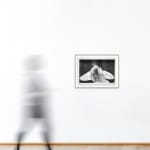Leonard Baskin American, 1922-2000
Sold unframed
Further images
About the Work
Dierdre is a woodcut print by American artist Leonard Baskin, created in 1964. This artwork is representative of the prints for which Baskin became renowned: oversized, black-and-white woodcuts that depict a single figure in states of pensiveness and angst. The subject of this woodcut is likely Dierdre, an ill-fated heroine from Irish mythology, whose story aligns with the artist's preference for macabre literary themes.
Baskin produced these woodcuts by carving images into woodblocks, applying ink to the surface, and carefully pressing paper onto the block with a roller. Along with artist Carol Summers, Baskin was among the first to carve and press prints on wooden blocks that were significantly larger than those traditionally used in Japanese woodcut production. This innovative process pioneered the creation of "monumental woodcuts," allowing Baskin's subjects' strong emotions to have a greater impact.
This work was printed and published in 1964 by Gehenna Press in Northampton, Massachusetts, a distinguished printmaking studio founded by the artist.
An IAC specialist has treated the print to restore the depth and brightness of the black-and-white ink, as well as the translucence of the rice paper. For more information, please get in touch with the gallery.
Collette uses cookies to create a more artful experience.
Join our mailing list
Subscribe to our mailing list to receive emails on upcoming exhibitions, available works, events, and more.











